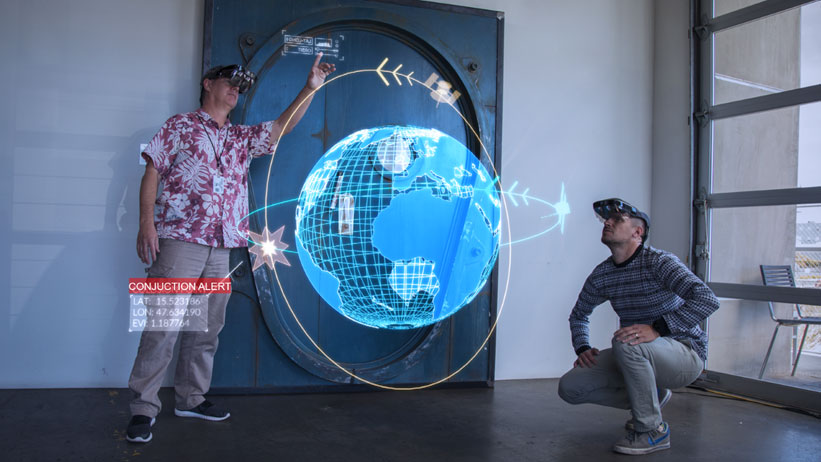 Zoic Labs’ conceptual design for augmented reality demonstration for HIRT. Zoic Labs developed a satellite collision trajectory visualization application with Ball Aerospace for the Air Force Research Lab’s Electromagnetic Spectrum Situation Awareness Operating Picture. The goal was to build a user-defined operating picture using novel visualization approaches for better understanding by non-EM experts. (Source: Zoic Labs)
Zoic Labs’ conceptual design for augmented reality demonstration for HIRT. Zoic Labs developed a satellite collision trajectory visualization application with Ball Aerospace for the Air Force Research Lab’s Electromagnetic Spectrum Situation Awareness Operating Picture. The goal was to build a user-defined operating picture using novel visualization approaches for better understanding by non-EM experts. (Source: Zoic Labs)
ALEXANDRIA, Va. — Futuristic data visualization tools in the spirit of “Minority Report” and “Ironman” inspire the work of Zoic Labs, an advanced software and data analytics company spun off from a Hollywood visual effects studio.
The company has brought its expertise working on over 1,000 movie and TV productions—including the above titles, “Battlestar Galactica” and “Avengers: Age of Ultron”—to the U.S. Department of Defense and Intelligence Community to help manage the high-volume, high-quality data collected by space-borne and other sensors, and deliver it on platforms with a Hollywood-quality user interface.
“People don’t realize that UX/UI [user experience/user interface] has a huge impact,” Zoic Labs CTO Saker Klippsten explained in an interview with Constellations.
Data displays, graphics, theming, intuitive controls and other seemingly cosmetic issues become important for users in mission critical areas that require full attention over long time periods at a screen. For example, Zoic Labs contracted with Slingshot Aerospace on the visualization component of the Space Force’s Next Gen OPIR missile warning and tracking system. Even though the project is serious, the key is making an interface that’s fun to use and visually engaging, Klippsten noted.
“We’re recruiting a new generation of analysts and warfighters and kids who have grown up playing video games of a certain level and quality,” he continued. The next generation expects the flashy interfaces they see in recruitment commercials. More often, they wind up with decades-old software (sometimes even on floppy disks) that cannot be upgraded.
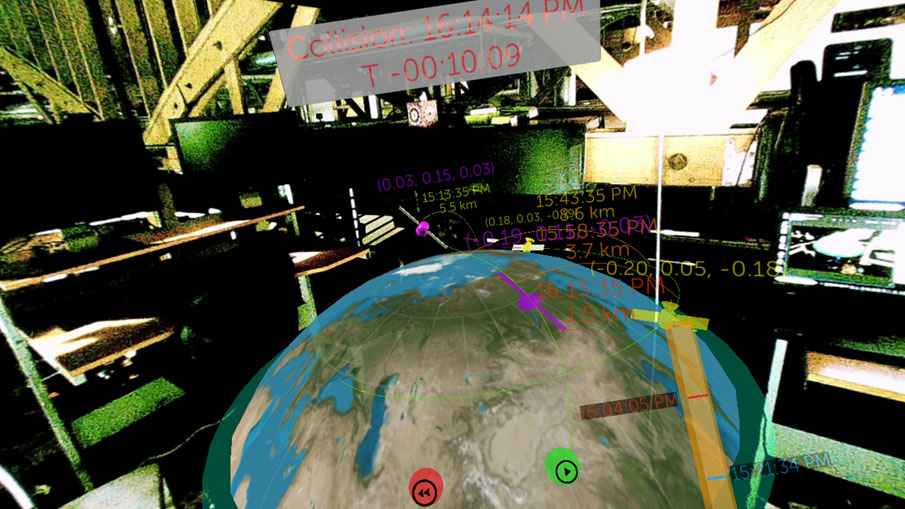 A demonstration of the augmented reality demonstration for HIRT showing orbital parameters and a data billboard with a collision countdown. (Source: Zoic Labs)
A demonstration of the augmented reality demonstration for HIRT showing orbital parameters and a data billboard with a collision countdown. (Source: Zoic Labs)
Zoic hopes to see that paradigm change to regular software refresh based on user feedback and mission needs. At the same time, it is in discussions about immersive augmented reality and virtual reality training platforms for operators in the space domain.
“Space is a hard thing to wrap your head around,” Klippsten said. Desktop 2D or 3D representations on a screen don’t capture the domain as effectively as AR or VR visualizations, which Zoic sees as “perfect choices” for the future generation of warfighters that is typically more comfortable exploring those technologies.
Big Data, Big Pipelines
Hollywood and the military may seem worlds apart, but they share some similar problems of data management. Both demand platforms to manage disparate data and to quickly move very high-resolution imagery across a virtual work environment.
“The government senses this is valuable—that they need to have a proper end-to-end pipeline for collecting, absorbing, manipulating, understanding and then decision-making on all that data,” Klippsten said.
In its government work, Zoic is focused on developing broad data pipelines for visual, RF, infrared, hyperspectral and other information. Early this year, the company won a contract with DIA to provide visualization capabilities, big data, data management and analytics for the Machine-Assisted Analytic Rapid-Repository System (MARS). The system is designed to replace DIA’s military intelligence database with a more flexible, user-friendly system able to ingest and analyze massive amounts of national security data.
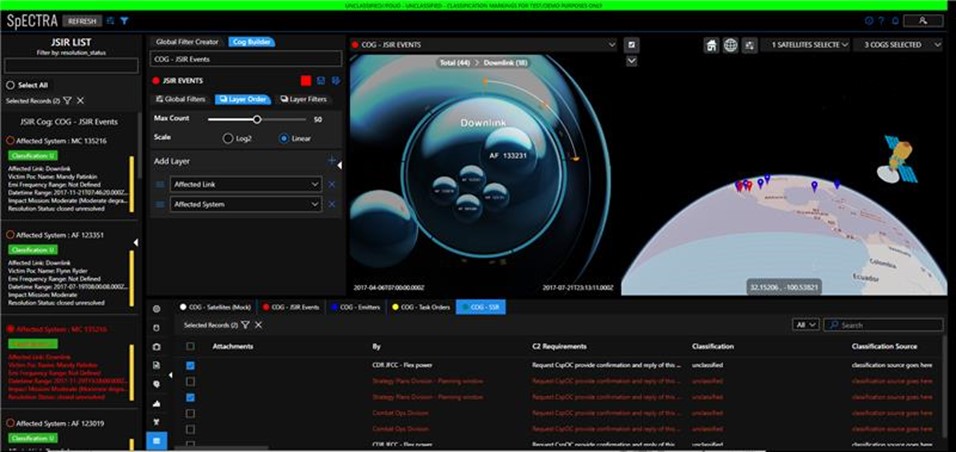
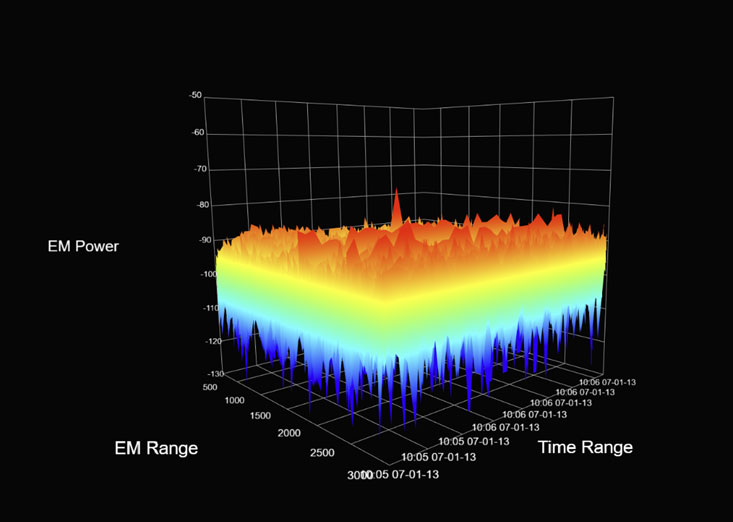 Zoic Labs’ SpECTRA is an electromagnetic spectrum management and visualization tool that provides users with varied and dynamic ways to study and understand interference reports, sensory data, tasking orders and support requests. SpECTRA was developed in partnership with Ball Aerospace and originated as an Air Force Research Lab (AFRL) prototype in conjunction with the National Spectrum Consortium (NSC). (Source: Zoic Labs)
Zoic Labs’ SpECTRA is an electromagnetic spectrum management and visualization tool that provides users with varied and dynamic ways to study and understand interference reports, sensory data, tasking orders and support requests. SpECTRA was developed in partnership with Ball Aerospace and originated as an Air Force Research Lab (AFRL) prototype in conjunction with the National Spectrum Consortium (NSC). (Source: Zoic Labs)
All source data is preserved after its ingested and Zoic Labs’ software organizes it in a format that can add value for different users.
Klippsten compared the process to film, where there’s a director’s cut, the studio cut, a producer’s cut and so on. “People want to look at things in a different way. We want to give that ability to the operator and ultimately to their supervisor and decisionmakers to look at these pixels uniquely and make the decisions from there.”
A ‘Huge Mind-Change’
Public remarks by leaders in the U.S. Space Force leaders, Defense Intelligence Agency and others, have repeatedly identified challenges making sense of datasets from various sensors, operated by different vendors across both classified and commercial channels.
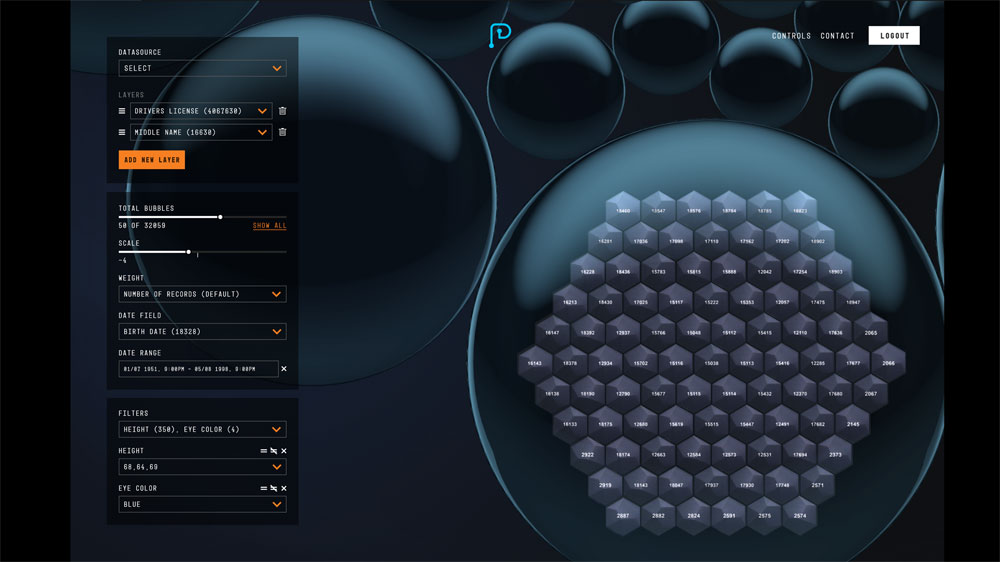 Zoic Labs’ PetriCore® is a node-based data visualization platform, designed to ingest, aggregate and display disparate datasets in a 3D immersive environment. The proprietary data aggregator gives dynamic visual feedback, allowing users to drill down into data using a circle packing algorithm, with real-time rendering, facilitating data rearrangement and precise analysis. (Source: Zoic Labs)
Zoic Labs’ PetriCore® is a node-based data visualization platform, designed to ingest, aggregate and display disparate datasets in a 3D immersive environment. The proprietary data aggregator gives dynamic visual feedback, allowing users to drill down into data using a circle packing algorithm, with real-time rendering, facilitating data rearrangement and precise analysis. (Source: Zoic Labs)
“It can get really confusing,” Klippsten noted. “We have to build software that can support importing into our applications all those different types of file formats.”
Time spent pulling in proprietary data, converting it, manipulating it and then exporting it isn’t feasible in the film industry, where artists are delivering visualizations with rapid turnaround. It’s even less feasible in mission critical areas for the military—like accessing real-time sensor data for space domain awareness or missile tracking and warning.
There’s room to question whether the government wants to solve its big data problems, particularly given the chronic issues around classification, vendor lock-in and an acquisitions process that can up to a year to get on contract. After Zoic Studios’ experience working on the Netflix satire “Space Force,” Zoic Labs is hopeful life won’t parody art.
“What we’ve tried to do in the visual effects world that I’d love to try in the government world is to create more standards for open exchange file formats that are open source,” Klippsten said. “It’s going to take a huge mind change to make that happen. Hopefully it does.”
Explore More:
Podcast: Satellite Data, Visualization and Finding Needles in the Haystack
Why DIA Wants More Commercial SDA Partners
‘Free the Data’: US Space Systems Command Calls for Greater Info-Sharing
